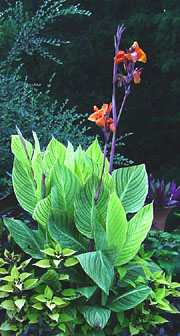Container gardening secrets are revealed in Cornell Plantations display and new brochure
By Roger Segelken

Summer visitors to Cornell Plantations have been marveling at the brilliant flowers and foliage in the container plantings on display at Plantations' Lewis Education Center. Now the Plantations gardeners who created the display are sharing tips for successful container horticulture in a newly published brochure, which is available free of charge at the Plantations gift shop.
"This display, along with an informative interpretive brochure, was made possible through the generosity and thoughtfulness of the Cornell Class of '53," notes Plantations Director Don Rakow. The container gardens were officially dedicated in June 2003, at the class's 50th reunion.
Although not new, container gardening is gaining popularity for small spaces and as a way to accent existing gardens. There are infinite varieties of containers and plants to choose from when designing a container garden; gardeners are limited only by their imagination. When choosing plants, says Plantations' landscape designer Irene Lekstutis, select those with colorful foliage and flowers, and interesting textures and growth habits. "Think about complementary colors, forms, textures and lines within your container," she adds.

- Tall plants with structural form, like canna, add a strong vertical line. These plants can be effective singly in a container for dramatic effect or used in mixed containers as a focal point. Filler plants like coleus are useful for massing around structural plants in mixed containers or by themselves as accents. Edging or cascading plants like lantana spilling down the sides or weaving through the planting, will tie the container together, soften the edges, and add layers of contrasting flowers and foliage.
- Plantations gardeners use one of several commercially available soilless mixes to retain the water, nutrients and oxygen needed for plant growth in container plantings. Fertilizing is also a regular part of the regimen. Container plants require frequent watering; pots exposed to full sun and desiccating breezes may need watering as often as twice a day. Container plants should be gradually "hardened off" to prevent sun and windburn prior to being put outside.
Like other Plantations collections, the container gardens display is open, free of charge, to the public during daylight hours. For more information on this and other Cornell Plantations gardens, stop by the Garden Gift Shop, featuring books, clothing and other gifts for nature lovers; it's open weekdays from 9 a.m. to 4 p.m.; and Saturdays and Sundays from 11 a.m. to 4 p.m. during the spring and summer. Or call (607) 255-2400; visit the Plantations Web site at http://www.plantations.cornell.edu/ ; or e-mail plantations@cornell.edu .
Media Contact
Get Cornell news delivered right to your inbox.
Subscribe